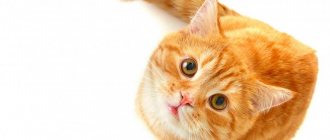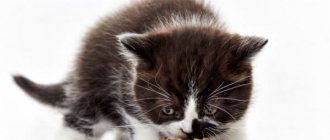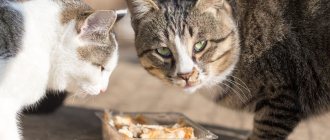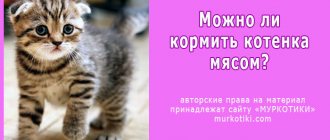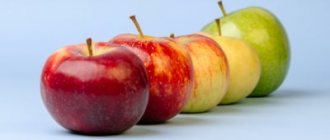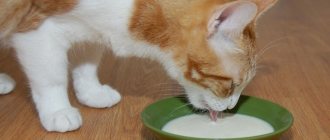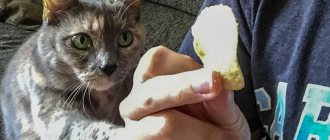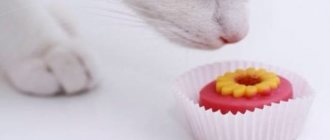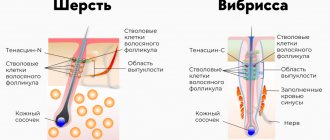If a cat eats potatoes or gnaws on raw tubers, this indicates a lack of potassium, vitamins C and E, as well as other useful substances in the animal’s body. But you should not abuse this product, especially when preparing a diet for kittens. In such situations, it is better to consult with a veterinarian, who will tell you what vitamins and supplements should be included in your pet’s menu.
Can a cat have mashed potatoes?
Typically, mashed potatoes are prepared from potatoes, adding butter and boiled milk. As a result, it turns out to be a very tasty and satisfying dish. While cats can definitely eat butter and milk, the most questions arise precisely because they can eat potatoes, because they are considered a carbohydrate and contain a lot of starch. Veterinarians tirelessly repeat that a specific product is actually not as dangerous as its quantity. That is, if we consider potatoes as a food product for a cat, it should be noted that they are not harmful to them; on the contrary, they contain many vitamins and minerals.
However, it is often impossible to give it, this is due to the fact that 70% of a cat’s diet should consist of meat; if you feed the animal with vegetables and fruits often, it turns out that the most important thing is that the pet will receive proteins and fats in smaller quantities than necessary, and This cannot be allowed. The consequences of improperly organized nutrition can be chronic diseases of the gastrointestinal tract, growth retardation, weakening of muscle tissue
Potatoes should not be given often because they are a starchy carbohydrate, and there are no necessary enzymes in the cat’s gastrointestinal tract to break them down.
In large quantities, potatoes simply clog the animal’s stomach and this is fraught with many digestive problems in the future. Therefore, if your cat often eats meat and fish or dry food, you can offer her mashed potatoes, like other vegetable purees, but several times a month.
What are the harms of potatoes for cats?
Potatoes contain starch. If you study the composition of industrial feeds, you will notice that there is starch there too. But it is added to ready-made canned food in small quantities to improve the structure of the food - it thickens and ensures a uniform consistency of wet food, and fixes the shape of granules - dry food. But there is not much starch in food: such an amount cannot harm the body of pets, it performs a purely technological function.
But natural potatoes contain a lot of starch - about 24%, and it is almost not absorbed in the cat's body. Is your cat gnawing on raw potato tubers? Stop her - it's very dangerous! Animals cannot digest raw starch at all and can clog the intestines. Instead of benefiting from potatoes, your pet may end up with indigestion and other digestive problems.
Useful properties of potatoes
In a herbaceous plant of the nightshade family, only tubers are eaten. People consider potatoes to be “second bread,” and for good reason. Along with starch, the product contains a balanced complex of amino acids, vitamins A, groups B, C, H, PP. Potatoes contain folic acid and all the minerals necessary for the body, including calcium, potassium, magnesium, iron, iodine, etc. This composition is useful not only for people, but also for pets:
| Cellulose | Which is contained in potatoes, helps normalize digestion, supports the development of beneficial microflora. The diet of cats, whether industrial feed or natural food, should contain at least 2-3% fiber. For animals leading a sedentary lifestyle, older cats, and representatives of furry breeds, more is needed. Lastly, it helps get rid of hairballs that accumulate during licking and clog the intestines; |
| Vitamin A | Provides vision for domestic hunters and maintains the beauty of the coat; |
| Vitamins B | Important for strengthening the nervous system, ensuring rapid healing of the skin when damaged; |
| Vitamin C | Supports strong immunity, normalizes metabolism. Potatoes are a storehouse of useful substances; 100 g contains 20 mg of vitamin C. Eating root vegetables not only increases the body’s defenses, but also supports the respiratory system and improves vascular elasticity; |
| Vitamin E | It is necessary for the cat’s body to maintain the health of the nervous and musculoskeletal systems. |
Micro- and macroelements play an equally important role in a cat’s body. Calcium is an important element that is necessary for the animal’s bones and joints, as well as its teeth, to be strong. Of the minerals, root vegetables contain the most potassium. It supports the functioning of the heart and vascular system, helps maintain normal water-salt balance and the nervous system. If there is not enough potassium in the animal’s body, heart rhythm disturbances, increased nervous excitability, and perverted appetite are possible.
Copper is involved in the formation of bone and joint tissues and has antioxidant properties. Iodine supports the functioning of the thyroid gland and participates in metabolic processes in the animal’s body.
Eating potatoes helps reduce cholesterol levels in the blood, normalizes metabolic processes in the body - it has the ability to neutralize the effects of acids in the body. However, do not rush to add potatoes to your cat's diet. In addition to useful substances, it also contains components that are undesirable for the animal’s body.
Diet planning
One adult animal weighing about 4 kg needs about 200 grams of natural food per day. For castrated males or female cats, this rate should be reduced, since due to changes in the functioning of hormones, metabolic processes slow down. As a result, the animal may become obese.
The general percentage composition of the correct diet for a cat is as follows:
- 70% protein foods (raw or boiled beef, poultry, rabbit).
- 20% raw or boiled vegetables.
- 10% boiled porridge.
The basis of the food is meat . This is an indispensable product that allows the animal to be healthy, gain energy and have beautiful skin and coat.
Meat contains those amino acids that are extremely necessary for the animal and are not found anywhere else, namely:
- Biotin (essential for healthy skin and coat).
- Taurine (found only in fish and beef, responsible for the health of blood vessels, nervous and reproductive systems).
- Arginine (responsible for metabolic processes in the body and the production of hormones).
It is important to remember that cooking meat destroys these amino acids.
Also, fats and proteins enter the cat’s body with animal products. They participate in the structure of body cells and are the main supplier of energy for an active cat.
Fish is also a good supplier of protein and rare amino acids, but it is not recommended to give it more than once every few weeks, and it is completely prohibited for castrated cats. This is due to the fact that this product contributes to the appearance of urolithiasis in cats.
In addition to these products, fermented milk products (kefir, fermented baked milk, cottage cheese) and eggs (only boiled or raw yolk) can be added to the cat’s diet.
In addition to meat, a healthy animal needs vegetables. It is an indispensable supplier of fiber and vitamins. Vegetables normalize the functioning of the gastrointestinal tract, and can be either raw or boiled. You can add to your daily diet: carrots, cabbage, sweet potatoes, spinach.
In last place are cereal crops. This could be boiled rice, oatmeal, or corn kernels. They are added to food in the form of a ground paste.
Can cats eat potatoes? Are they healthy and safe?
Potatoes in any cooked form are an excellent source of various vitamins, proteins and fiber for humans. But is it safe to give your cat potatoes? Are they good or bad?
Cats are natural carnivores. Thus, their main food is meat and meat by-products. Some high-quality dry or wet cat foods contain not only meat, but also plant-based ingredients such as oils and other plant by-products. However, when your kitty comes asking for a spoonful of your frozen yogurt, a piece of your chocolate, or a piece of your delicious bag of chips How can you refuse the hungry look of this precious little furball?
So, can cats eat potatoes?
Yes and no.
It really depends on the type of potato and how you cook it. For example, cats are intolerant of sweet potatoes. French fries also pose a threat to your kitty's digestive system. And raw potatoes are absolutely fatal to cats.
Let's look at the different types of potatoes and how they benefit or harm your furball.
Raw potatoes
Raw potatoes can be just as poisonous to cats as they are to people.
The raw potato plant contains the toxic chemical solanine. This chemical acts as a defense mechanism for growing potatoes and is poisonous to all humans and animals, including felines.
Apart from being present in the plant, this chemical can also be found in the green skin of ripening potatoes. So, eating raw potatoes and peeling raw potatoes is absolutely lethal to your kitty.
So, if you keep raw potatoes at home, to be safe, make sure they are out of your cat's reach, or you may find yourself rushing to the vet's office.
Sweet potato
Sweet potatoes, even the green ones, do not contain solanine. The ASPCA has designated sweet potatoes as non-toxic to felines.
However, sweet potatoes can cause a variety of health problems in cats. Cats have a harder time digesting potatoes than humans, and the nutritional value of sweet potatoes is not as beneficial for cats as it is for humans.
High-quality cat food offers all the nutrition a cat needs, so you don't have to treat your cat's furball with potatoes to give him extra nutrients.
A small piece of mashed sweet potato won't harm your kitty, but if you serve it as an occasional treat, it can lead to obesity, digestive problems and other health problems, including vomiting and diarrhea.
Boiled potatoes
If raw and sweet potatoes are bad for kittens, can cats eat boiled potatoes?
Mashed, baked or boiled potato dishes are completely safe for your pet. Some cat foods even contain potato ingredients. Boiled potatoes are safe because toxins are destroyed during the cooking process.
You can add mashed potatoes to your cat's dry or canned food from time to time to give your cat extra protein and fiber, even though it should not replace a vitamin supplement.
However, you should always remember that in the prepared potato delicacy it is necessary to get rid of harmful spices and herbs, artificial additives and fillings. Sweet and sour fillings pose a mortal danger to cats, so their use is prohibited.
Fried potatoes are not as safe as boiled, mashed or baked potatoes. They contain unhealthy oils, acids and fats that can harm your kitten. It's the same with chips and fries - artificial flavors, herbs, salts and other additives in a bag of chips will have unpleasant consequences for your precious kitty.
So, let's summarize.
Cats can eat potatoes and they may find them tasty. A treat or two of sweet potatoes or fried chips won't hurt your feline pal if it's a one-time thing, but it can be fatal in the long run. Boiled, baked and boiled potatoes are safe for cats, but not in everyday life.
Last but not least, try not to share food with your kitten too often, as this will ruin his appetite, make the cat more demanding and spoil his balanced diet. >> Provide your cat with a healthy and rich diet by giving her the best foods from our list here
>> Provide your cat with a healthy and rich diet by giving her the best foods from our list here
Can cats eat sweet potatoes?
Compared to white potatoes, sweet potatoes are more nutritious. Therefore, it is considered one of the most useful potato varieties... for humans. But not for cats. Most cats do not tolerate sweet potatoes well.
The American Society for the Prevention of Cruelty to Animals (ASPCA) even lists sweet potatoes as dangerous to cats.
If your cat accidentally eats some sweet mashed potatoes, will it harm her? Most likely no. However, be sure to monitor how she reacts to such food. Pay special attention to signs of digestive upset - diarrhea and vomiting.
If a cat has had an adverse reaction, sweet potatoes should be completely eliminated from its diet. Potatoes have no advantages over other products for cats.
, a cat can easily get all its nutrients from other sources.
Tips for cat owners
- If it was decided to introduce pasta into the cat's diet, it is best to choose products made from durum wheat.
- The best addition to pasta is cheese.
- Mayonnaise and ketchup, which people love to add to pasta, are not the best food option for cats, as a result, owners must understand one fact - no matter how much their pets beg for food, they should not be fed from their plate.
- Pasta is given throughout the week - 1 or 2 times, so the menu for the cat should be carefully planned and all necessary food products containing useful elements should be distributed equally throughout the day.
- If your cat begins to gain weight, it is better to give up pasta for a while, or even better not to give it to her at all.
Vegetables for cats
When planning to feed your cat healthy treats, you need to take into account the fact that pets’ intestines have their own structural features. Without knowing what vegetables you can give your cat, you risk harming the animal. The length of the intestines is very short, so fluffies do not have the ability to efficiently digest the plant fiber contained in the pulp of vegetables.
This means that hard-to-digest vegetables are not suitable for feeding. So, the first requirement is that fiber should be easily digestible. The answer to the question of which vegetables are good for cats is the following list:
Can cats have green vegetables? Since magnesium, vitamin D, vitamin C and many of the minerals contained in greens are essential for pets, they are added to the cat's diet. Green beans, lettuce and cucumbers can be used in a variety of dishes.
The short intestine is ready to digest protein foods: meat or fish; other products can only dilute the bulk of the protein food. Vegetables in the proposed food should be no more than 15%. This is the second basic rule that should be applied when creating a menu for your pet.
Nutritional value of potatoes for cats
Let's look at how the substances that make up potatoes affect the cat's body:
- starch is almost not digestible, in its raw form it is not digested at all. In large quantities, it clogs the intestines, leading to indigestion and flatulence;
- fiber – normalizes digestion, absorbs excess liquid during diarrhea, serves as a substrate for beneficial microflora. The feed should contain about 2–3% fiber (by dry matter weight). It is especially useful for sedentary and elderly animals suffering from obesity, as well as furry breeds, in whose stomach hairballs constantly form;
- potassium – ensures the functioning of the heart and nervous system, is necessary for muscles, maintains water balance in the body;
- copper is an antioxidant, participates in the formation of bone tissue and collagen;
- Vitamin A – improves vision, makes the coat thick and shiny;
- B vitamins – strengthen the nervous system, accelerate skin regeneration, healing of cracks and wounds;
- Vitamin E – supports the health of the nervous system and muscles (especially needed for pregnant cats);
- Vitamin C – strengthens the immune system, normalizes metabolism.
Many well-known premium and holistic food manufacturers add potatoes to their products:
- Acana;
- Golden Eagle Holistic;
- Orijen.
Potatoes are essential in dry food for cats with gluten allergies. The tubers are processed in a special way, removing most of the starch, but retaining the beneficial substances.
Benefits and harms
Thanks to this root vegetable, pets' skin lesions heal better. Adding potatoes to a kitten's diet has both positive and negative sides. The advantages of such nutrition include the fact that the vitamins contained in the vegetable have the following effects on the body:
- improve visual functions;
- make the coat thick;
- improve immunity and nervous system;
- normalize metabolism;
- accelerate wound healing.
Useful substances such as copper and potassium are necessary for building bone tissue and muscles and maintaining the functioning of the heart. Fiber is an essential component for normal digestion. During diarrhea, it removes fluid and helps remove hairballs that form in the gastrointestinal tract of cats. The benefits of potatoes are also evidenced by the fact that many feeds contain this product. The downside of kittens eating root vegetables is the high starch content in the product. This component clogs the intestines, is very poorly digested or not digested at all, which leads to indigestion and flatulence.
Is pasta harmful or healthy?
By nature, cats are predators. They prefer meat as their main food. In the wild, cats will not refuse to feast on small rodents and birds, which, in turn, feed on plant grains. Thus, the contents of the stomach of its victim also enter the cat’s stomach, that is, plant food, which is completely absorbed by the cat’s body. From this we can conclude that there is nothing wrong with a cat eating a little pasta.
What is pasta, and what beneficial substances will your pet get from this food? It is widely believed that the product is very high in calories, and this is undesirable not only for people, but also for pets, especially those couch potatoes whose physical activity consists of moving along the “kitchen-bed” route.
However, pasta contains a lot of useful substances. Carbohydrates, which are rich in flour products made from durum wheat, are a source of energy. And although the diet of a domestic cat should largely consist of proteins, it also needs carbohydrates. Moreover, pasta contains so-called “long” carbohydrates, which, unlike short ones, do not provide a quick burst of energy, but saturate well and provide a long-term supply of energy.
In addition, pasta contains:
- vitamins of group B, E, PP;
- minerals – magnesium, iron, potassium, phosphorus, calcium;
- fiber, which improves digestion and promotes the removal of toxins and heavy metal salts from the body.
Pasta contains a small amount of vegetable protein, which, although digested worse than animal protein, is nevertheless beneficial for the body. There is very little fat in pasta, so such food cannot be called harmful, although it cannot be made the basis of a pet’s diet.
Important!
It is not the pasta itself that is harmful, but the additives to it - butter, sauces, gravy. The cat definitely doesn’t need them!
Vegetables as a source of dietary fiber
- Fiber is necessary for the intestines to function properly. However, the deserted (= sparsely populated) digestive tract can process it due to its special structure. However, in terms of usefulness in the literal sense of the word, it’s not worth considering dietary fiber from this side. But fiber is needed as a brush to cleanse the intestines and speed up digestion. Sympathy forms feces and reduces the risk of congestion.
- Meanwhile, other valuable substances contained in vegetables are absorbed and must be absorbed into the body. This is especially true for those crops that the adopted child consumes with pleasure. If the cat is overweight, pickles will only be a plus. They create a feeling of fullness, are low in calories and make stool liquid.
- Veterinarians specializing in dietology and nutrition for cats claim that in the presence of excess weight, vegetables are introduced into the animal’s menu in the amount of 15% of the daily menu. However, at the same time, it is necessary to equip the cat with sufficient meat. It is important to know the norm and introduce vegetables close to the animal first in small portions. Abrupt introduction of such products into the catalog will lead to diarrhea, vomiting, and fecal incontinence.
Reasons for this behavior
The etiology of this condition has not been fully studied, but it is safe to say that by eating soil, cats do not intend to misbehave or upset their owners, so there is no point in punishing them for this.
Analyzing the health status of pets with this bad habit, experienced veterinarians came to the conclusion that, in most cases, pica in cats is evidence of medical abnormalities. It can be:
- psychological disorders;
- infection with certain types of parasites;
- lack of certain vitamins and microelements in the body;
- the need to cleanse the gastrointestinal tract.
If a cat eats dirt, this may indicate that he is stressed or depressed. Any stressful situation can lead to changes in behavior. Cats react to stress differently. The characteristics of the breed and character are of great importance. If an animal has never suffered from lack of attention and affection and has always received good nutrition, then it will be better able to cope with the negative consequences of unpleasant situations. This cannot be said about those animals whose fate was not so successful.
This type of pica can develop in a cat that has experienced a strong feeling of hunger in extreme conditions (for example, if, as a kitten, it almost died of starvation after getting lost on the street).
Stress and depression in cats can also be triggered by the following situations:
moving to a new apartment, change of owner; sitting alone for long periods of time; the appearance of new people in the house or competition with another cat; uncomfortable living conditions; unsatisfied need to communicate with the owner; insufficient attention to it.
To eliminate behavioral problems, it is necessary to eliminate the unfavorable factors that caused stress or depression
To do this, you should provide your pet with increased care and attention and eliminate the lack of communication. In severe cases, you will have to give him sedatives and antidepressants prescribed by a veterinarian
We invite you to read: Ketosteril for cats: instructions for use, indications and side effects
A cat's greedy eating of soil may indicate infection with worms. In nature, animals often swallow sand in order to rid themselves of internal parasites. The domestic cat, following the same instinct, often eats soil from a flower pot or cat litter.
Therefore, the animal should be urgently dewormed using broad-spectrum antihelminthic drugs if the following signs of a cat being infected with worms are present:
- weight loss;
- dull, tousled fur;
- bloated stomach;
- frequent vomiting;
- weeping, festering eyes;
- unpleasant odor from the mouth.
These are potassium and calcium, sodium and phosphorus. If this is the reason, then you need to balance the cat’s diet by adding ash to the food - a source of magnesium and related microelements. It is believed that a cat that eats a lot of meat may experience a lack of minerals. It can remove calcium from the body, which creates a risk of developing osteoporosis and rickets.
It is not recommended to give your animal synthetic vitamins and microelements on your own. A veterinarian must make the necessary appointments.
To enrich the cat's diet with vitamins and herbs, you can plant peas, oats, wheat, barley, and rapeseed in a shallow container for the cat.
Iron deficiency anemia can also be a cause of food perversions. This disease occurs especially often in kittens during their active growth period. The disease can be recognized by the pallor of the mucous membranes, bradycardia, and general lethargy. The diagnosis is confirmed by the result of a blood test for iron content. To treat severe anemia, special injectable drugs (Ferrum Lek and Erythrostim) may be needed.
The cat must periodically clean its stomach of hair that gets there after licking. She usually uses grass for this purpose. There is a version that at home a cat's stomach brush is soil from flower pots. It is recommended to specially grow grass at home for the cat, which he could use for this purpose. You can also give her a special paste to remove swallowed fur from the gastrointestinal tract.
Unpeeled Potatoes
Many cats love to eat raw second bread, but an excessive amount can become a source of problems that adversely affect the life of a domestic predator. A large amount of starch clogs the stomach and promotes bloating, in which the pet may need help from a veterinary clinic due to indigestion, that is, a rise in high temperature due to disruption of the intestinal tract.
In this case, a clean and peeled vegetable contains potassium, fiber and copper, which has a beneficial effect on the condition of the animal’s coat, muscle mass and the functioning of the digestive system. Of course, the microelements contained in potatoes are relevant for cats of any age, because during the reproductive period they strengthen the muscular system, and at an older age they improve the animal’s amblyopia and sense of smell.
Many feed manufacturers, based on research from scientists with their eyes open, add crushed potatoes to concentrated feeds, wanting to vary the diet of their potential consumers. Today, ultimo on the shelves of specialized stores can even provide food for animals with gluten allergies. In such situations, the tuber is processed using a special technique that removes starch while maintaining other beneficial properties.
Pros and cons of potatoes in a cat's diet
Experts do not have a consensus on whether to give cats boiled mashed potatoes or not. Some consider raw potatoes to be poison for pets, while others, on the contrary, believe that potatoes contain enough nutrients that are beneficial for cats and are healthy. In principle, a large number of pets that lived to an old age ate potatoes.
Related article: Can nursing mothers eat potatoes: boiled, fried, stewed?
So where is the truth? But the truth lies in the golden mean. This product contains both beneficial and harmful substances for cats; let’s take a closer look at this information.
Vegetables for cats: give raw or boiled
How to organize vegetable complementary food; should your cat cook vegetables or give them raw? It is necessary to boil them and add them soft to meat puree or to purchased food that is familiar to the animal.
To the question of what vegetables can be given to cats raw, the answer is - only cucumbers. They don't eat the rest raw. Rarely do animals, out of their personal preferences, nibble on zucchini or potatoes - vegetables that are good for cats, both raw and boiled.
Cucumbers contain a large amount of microelements and are also high in moisture content. If your pet's diet is not rich in minerals, it is quite possible that even a raw cucumber will be to her taste. Cats living in summer cottages often nibble on fresh cucumbers. It is not safe to give cucumbers to nursing cats and kittens: the vegetable, which has a diuretic effect, can provoke the development of urolithiasis.
Raw potatoes: pros and cons in the diet of pets
What is the benefit of raw potatoes in the diet of pets? Is it possible to eat raw potatoes? A question that interests many modern farmers. According to generally accepted opinion, potatoes as a vegetable do not contain anything useful, being a source of large amounts of starch and carbohydrates. But at the same time, in its raw form, potatoes contain natural enzymes that help the animal’s body work faster. It is also known that potatoes have a high content of potassium and fiber, so they are beneficial for many animals.
With all this, some animals are contraindicated in copious amounts of raw potatoes, as they can cause upset or even poisoning. It also contains little protein and mineral salts, which can adversely affect the pet’s health.
https://www.youtube.com/watch?v=https:zVP64Odd91M
One of the reasons why it is also not recommended to give raw potatoes to animals is chemical treatment during the growing process. Now that the general picture of potato consumption by pets is approximately clear, let's try to understand it using the example of each of them.
The debate between dog handlers and veterinarians does not fade away even for a minute. The fact is that everything is individual - whether it is possible to eat raw potatoes depends on each breed of dog and its digestive characteristics. Many breeds do not experience any harm to the body from potatoes, quite the contrary. Others suffer from diarrhea and even volvulus, which adversely affects their well-being and leads to serious consequences.
At the same time, some nutritionists believe that nothing critical can happen to a dog’s body from eating one potato a day. On the contrary, your pet’s body will be saturated with essential carbohydrates and fiber. Is it possible for your pet to eat raw potatoes? The main thing here is not to overdo it and approach this issue wisely.
Cooked potatoes
Veterinarians urge cat owners to remember that the best option is to include cooked potatoes in moderate doses in the diet. The optimal norm is 1-2 spoons per week, but you should follow some simple rules:
- Young boiled or baked potatoes contain a minimal amount of starch, so they are ideal for feeding animals.
- You should not flavor the dish with salt or seasonings, because this can lead to the development of urolithiasis in animals.
- Old potatoes must be peeled, soaked in water and cut into small pieces or crushed until smooth, after which they can be mixed with canned meat.
- Tubers that have turned green or have sprouts should never be given to an animal, because they contain solanine, which is poisonous for cats.
- You should not mix potatoes with balanced dry food, because this will upset the animal’s nutritional balance, and in addition, the additive will reduce the smell of the food granules, making them uninteresting to a predator accustomed to relying on its sense of smell.
Prohibited foods for cats
Check out the list of prohibited foods and never give them to adult cats:
- Milk. Adult cats are strictly prohibited from any milk (cow's, goat's). As animals age, they develop lactose intolerance, which causes digestive disorders and diarrhea.
- Liver. A large amount of liver in the diet can cause vitamin A intoxication. As a result, osteoporosis develops and bones become deformed. Raw liver is also dangerous because it may contain helminth larvae - a risk of helminthic infestation.
- Raw meat. Before feeding, the meat must be frozen in a deep freezer and doused with boiling water before serving.
- Canned fish. Canned food for people contains a lot of oil and preservatives - this is harmful to the liver and can cause obesity.
- Raw freshwater fish – can contain all sorts of parasites.
- Sausages and smoked meat (lard), regardless of their composition, are harmful. These products are also human and contain a lot of fat, salt and other ingredients that are not necessary for the animal.
- Fatty meat, cottage cheese, dairy products, butter, cheese - all this is not necessary for a small pet, as it can lead to digestive problems and obesity.
- Bones, both fish and bird. The sharp edges of the bones can injure the esophagus, stomach or intestines, or become lodged in the throat.
- Raw chicken eggs. There is a high risk of infection with salmonellosis or E. coli. Only quail eggs are allowed in their raw form.
- Pork. Meat that is too fatty for cats can cause indigestion and diarrhea. In addition, pork meat is more likely than other varieties to be infected with helminth larvae and viral infections.
- Dry and wet dog foods do not contain the nutrients your cat needs. Eating dog food can lead to exhaustion and illness in your pet.
- Yeast dough and flour muffins based on it. Once in the cat's stomach, the dough swells and greatly stretches it - this causes severe pain. The breakdown product of yeast is alcohol, which can cause poisoning.
- Onions and garlic are very toxic to cats in any form: raw, powdered, or in food. Poisoning with onions and garlic causes gastrointestinal upset and, in advanced cases, causes anemia.
- Coffee, tea, cocoa and other products containing caffeine. Caffeine is a deadly substance for cats that causes rapid breathing and heart palpitations. In severe cases, cardiac arrest may occur.
- Chocolate. Contains a lot of sugar and a substance dangerous to animals - theobromine. Convulsions, tachycardia, and death are possible.
- Sugar, sweeteners and sweets. Large amounts of sugar lead to obesity and diabetes. Sweets often contain the sweetener xylitol, a substance toxic to pets. Xylitol poisoning may cause vomiting, convulsions, loss of coordination and lethargy. Possible development of liver failure.
- Grapes and raisins are toxic to pets. In case of poisoning, vomiting and hyperactivity occur. Provoke kidney failure.
- Mushrooms. Heavy and very toxic product. In case of mushroom poisoning, increased salivation, vomiting, and diarrhea are possible. Possible liver damage.
- Nuts. Some varieties of nuts (macadamia nuts, walnuts) are poisonous to cats, and excess fat content can cause diarrhea and vomiting.
- Alcohol. Poisons the brain and liver of the animal. Possible death.
Products that should not be abused
Of course, sometimes exceptions can be made. For example, chips seem to be very tasty for humans, but eating them all the time is highly undesirable. Likewise, for cats, for example, ice cream is harmful, but very rarely you can give it a spoon.
List of foods not recommended for cats:
- Apples. You can give a little at a time. Be sure to peel the peel and remove the seeds - they contain toxins and a toxic substance such as arsenic.
- Avocado. The peel and pit contain a dangerous toxin - persin, which causes gastrointestinal upset. The oily texture of avocado attracts cats; one small piece without the peel is quite harmless.
- Potato. Raw potatoes, leaves and stems of the plant contain the harmful substance solanine, a poisonous alkaloid. Potatoes can be given boiled, but they have no nutritional value for cats.
- Broccoli. You should not overfeed your pet with this type of cabbage; it contains a large amount of toxins. In moderation, broccoli is healthy.
- Bread and pasta in large quantities provoke flatulence and intestinal colic. A small piece of whole grain bread will not harm the animal.
Raw potatoes
Many cats love to eat raw potatoes, but excessive amounts can cause problems that negatively affect the life of a domestic predator. A large amount of starch clogs the stomach and promotes bloating, in which the pet may need professional help from a veterinary clinic due to indigestion or high fever due to disruption of the intestinal tract.
At the same time, clean and peeled potatoes contain potassium, fiber and copper, which has a beneficial effect on the condition of the animal’s coat, muscle mass and the functioning of the digestive system. All microelements contained in potatoes are relevant for cats of any age, because during the reproductive period they strengthen the muscular system, and as they age, they improve the animal’s vision and sense of smell.
Many feed manufacturers, based on scientific research, specifically add crushed potatoes to concentrated feeds, wanting to diversify the diet of their potential consumers. Today, on the shelves of specialized stores you can even find food for animals with gluten allergies. In such situations, potatoes are processed using a special technique that removes starch while maintaining other beneficial properties.
Which variety is best to give?
There are different types:
Most often we can find table beets because we often eat them ourselves. This vegetable can be given to your pet; it contains more beneficial microelements than other varieties.
Fodder - they feed pigs and cows on some farms, but your baby may also like this vegetable. It does not contain any particularly beneficial properties for the hamster.
Sugar beets can also be included in the diet, but be careful not to cause diabetes.
Can a cat have beets?
Professional foods such as Hill's and Royall Canine contain beet pulp as a source of fiber. Is it possible to give regular beets to a cat? If possible, then in what quantity and form?
Beets are a unique product. It is rich in various vitamins and salts. It contains almost all the macroelements, microelements and vitamins that an animal needs, and also includes a large number of amino acids necessary for the proper functioning of the body.
It is not recommended to give this vegetable raw to cats, as it has a pronounced laxative property. This can lead to disruption of the gastrointestinal system.
But when boiled, this product is good. It has a sweetish taste and is liked by many pets. However, there are a number of restrictions associated with eating beets.
The main thing is that beets cannot be used on an ongoing basis. It contains a large amount of sugars in the form of glucose, and this can lead to diabetes and pancreas problems in your pet. Which are extremely difficult to treat.
Using beets in the diet also has its advantages. Due to its composition, the acidity of cat urine increases significantly. This allows you to get rid of urolithiasis. Salts stop being deposited, dissolve and are eliminated from the body.
Often, in case of urolithiasis in an animal, veterinarians prescribe a course of beet juice or puree as an additive to the diet.
However, it is worth knowing when to stop everything. Since high acidity of urine can also lead to adverse effects on the cat's health.
Before deciding to feed your cat natural products, it is worth considering that this requires a lot of time and effort. It is necessary to take a responsible approach to planning your diet and choosing the products you use. However, if you choose this type of feeding, your cat’s body will thank you. You will notice how healthy, active and full of energy your animal is.
| BEST ANSWER |
| MORE ANSWERS |
It is probably more correct to talk not about the dangers of beets, but about the limitations in its use. They are also determined by the chemical composition of beets.
Osteoporosis, predisposition to it. This is due to the fact that beets interfere with the absorption of calcium.
Diabetes. Because it is a sweet vegetable, with a fairly high sugar content.
Urolithiasis (oxaluria primarily). Beets are contraindicated in this case because they contain oxalic acid. On the Internet you can find many folk recipes on the topic of treating kidney and bladder stones with beet juice. This should not be done under any circumstances!
Chronic diarrhea. Beets have a pronounced laxative effect.
Beetroot is a large group of root vegetables of the Amaranthaceae family. Its most famous types are: feed, sugar and table. From the name of the ingredient it is difficult to understand what beets are contained in this diet. When we read the ingredients, we usually imagine table beets: brown-purple root vegetables from store shelves. They contain many vitamins and minerals, have an antioxidant effect and help detoxify the body. However, beets are not typically used in dog or cat food.
It can be assumed that this is either fodder beet, or in this way the manufacturer designated beet pulp (or beet pulp) - waste from sugar beet processing after sugar removal for industrial purposes. In prepared animal feeds, this product is a source of healthy fiber (in moderation).
Fodder beets also contain vitamins and minerals, but they are very high in fiber. It is useful for cattle, but not for cats and dogs.
Overall food rating out of 55 possible points, including bonuses and penalties
Vegetable menu for your pet
Owners who feed their pets with ready-made diets do not need to create a full menu that includes healthy and necessary ingredients. When feeding naturally, the owner needs to balance the components when choosing foods that can be given to cats. The useful category includes:
- Zucchini - goes well with meat ingredients; they can be served raw, boiled or steamed.
- Beets - can be given in small quantities, after boiling, chopping and mixing with meat or offal. Large amounts can cause diarrhea in the animal.
- Broccoli – a little of this vegetable in your pet’s menu will provide his body with valuable bioflavonoids. But a large dose to a cat is dangerous because broccoli contains the toxin isothiocyanate.
- Cauliflower - a cat can be fed this product only after it has been heat treated.
- Carrots are rich in vitamins; pets can eat them raw or boiled. Suitable as an addition to almost any dish.
- Cucumber - a little raw vegetable will not harm your pet, unless we are talking about a nursing cat or an animal suffering from an intestinal disorder. It is not recommended to give canned and lightly salted cucumbers to cats.
- Spinach – finely chopped greens will enrich any dish with valuable microelements.
- Pumpkin – 1-2 tbsp. l. It is recommended to add pumpkin puree to your furry pet’s dishes. But it is better to avoid large amounts of this product, since excess fiber in the body can lead to upset of the animal’s digestive tract.
When including vegetables in your pet’s menu, we must not forget that they can make up no more than 20% of the total diet.
How to properly include potatoes in your cat's diet
You should not feed your cat potatoes too often. The norm is 1–2 teaspoons (about a quarter of a boiled tuber) once a week. It is recommended to follow the rules:
- It is allowed to give the animal only boiled or baked potatoes without salt and seasonings. Salt causes urolithiasis; potatoes are mashed and mixed with meat;
- Young potatoes containing little starch are preferable;
- Before cooking, old tubers should be thoroughly cleaned, washed, if you have time, cut into pieces and soak in cold water for at least an hour;
- Do not use green or sprouted tubers: solanine is poison for animals;
- You cannot feed your cat raw and fried potatoes;
- Do not mix potatoes with prepared food: both dry and wet. Ready-made food already contains the optimal amount of products a cat needs. By adding natural food to them, the owner upsets the balance. The simultaneous intake of prepared feed and natural products leads to dehydration of the animal's body.
If a cat eats potatoes for the first time, you need to take a closer look to see if your pet develops bloating, flatulence, constipation or diarrhea. In case of a negative reaction, the root vegetable should be completely excluded from the diet. It is not recommended to add crushed dried potatoes or potato flour to animal food: it is very difficult to calculate the required dose. In addition, these products often contain preservatives.
Sometimes cats show increased interest in potatoes: they beg their owner for a crispy piece or start gnawing on raw tubers. Perhaps the animal lacks potassium, silicon, vitamins C or E. In order not to harm the health of the pet, it is better not to indulge its tastes. In such cases, it makes sense to consult a veterinarian and introduce appropriate vitamins into the cat’s diet.
How to properly feed your cat potatoes
The animal's daily food intake is no more than 5% of the animal's weight. A balanced diet for domestic cats should include 70-75% meat. The remaining 15-20% of the diet should come from vegetables, and 10% from grains. Sometimes cereals can be replaced with potatoes. The norm would be to give no more than two teaspoons of boiled potatoes once a week. In this case, the following feeding rules should be observed:
- give your pet only boiled or baked potatoes, cooked without salt and spices;
- do not use green tubers - they contain solanine, a substance that is poisonous to humans, and even more so to a small pet;
- It is best not to use old potatoes for feeding. As an option, before cooking, peel and wash it well, then cut and soak for at least 1 hour in cold water. This will help remove excess starch from the tubers. Young potatoes contain less starch, so preference should be given to them;
- Do not mix boiled potatoes with wet food or canned food - it is better to mash it and mix it with meat.
Raw and fried potatoes should not be given to cats. The first contains a lot of starch that is not digestible by the body, in addition, due to the presence of the glycoalkaloid solanine in it, it is toxic. When cooked, solanine is destroyed. Therefore, make sure that the cat does not gnaw on raw tubers and does not “treat itself” to potato peelings.
Potatoes boiled in their skins are the healthiest: they retain almost all the nutrients. And for frying, oil and cooking fats are used. With such heat treatment in products containing starch, the content of acrylamide increases, which in the body provokes the release of glucose into the blood. In addition, scientists have proven that the dangerous carcinogen acrylamide damages DNA and provokes the development of cancerous tumors.
It is unlikely that anyone will fry potatoes especially for a cat - but the temptation to give your pet a spoonful or two of food from your plate is quite great. When you bring a spoon of fried potatoes to your cat's bowl, remember that you are bringing serious health problems there. The salt that you added to the product during frying is the first step to urolithiasis and heart failure for your pet. Fried potatoes are a high-calorie dish, hence the heaviness and discomfort in the stomach, and excess weight that your pet may develop.
When giving potatoes to your cat for the first time, observe its condition. The root vegetable can cause intestinal upset, bloating, and flatulence. If such signs are present, potatoes should be completely excluded from the diet.
